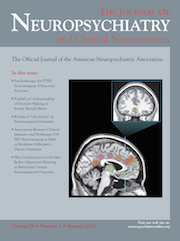To the Editor: Methylphenidate (MPH) is a central nervous system stimulant with limited peripheral actions
1 used to treat attention deficit hyperactivity disorder (ADHD) in children. At the central level, MPH, like cocaine, blocks the dopamine transporter (DAT), particularly in the striate body and the nucleus accumbens, both regions involved in the process of positive reinforcement and reward (which would be dysfunctional in ADHD).
2 MPH is generally well tolerated; most of its adverse effects are mild and/or temporary.
3 As defined in the DSM-IV-TR, ADHD is a persistent and highly disabling mental disorder that is characterized by patterns of inattention, hyperactivity, and marked impulsivity, often complicated by co-occurring substance use disorders.
4 It is estimated that 15%‒25% of cocaine abusers seeking treatment have ADHD.
5,6 A recent review of the literature suggests that research on treatments such as MPH or amphetamine analogs of cocaine could help identify effective therapeutic molecules.
7 MPH seems particularly promising, and a recent study showed its specific properties related to the mixed profile reuptake inhibitor of low-dose dopamine and deliverer of high-dose dopamine.
8 Case Report
We report the case of a 40-year-old married Caucasian man, who consulted our addictology department for cocaine addiction. During the first consultation, the patient met the DSM-IV-TR criteria for cocaine dependence. Cocaine consumption began at the age of 30, and its use continued in the last 2 years (approximately 5 g of cocaine four times a week). He also met the DSM-IV-TR criteria for gambling (he went in the casino twice a week since 2 years and had a debt of $3,000 [U.S.]) and told us about sex addiction (with frequent compulsive sex outside marriage). Cocaine abuse allowed him to be calmer, more focused, and helped him to get involved in his professional work. It is important to note that the effect he was looking for was not a psychostimulant effect.
He wanted to stop the cocaine use, which was increasing and becoming problematic in his daily life. He had no medical history and did not take any other drug or substance. Biological and somatic assessments (including electrocardiographic exam) showed no abnormality. A urine screen for cocaine was initially positive; we then measured responsiveness to MPH for abstinence from cocaine by this test, clinic examination, and Cocaine Craving Questionnaire-Brief (CCQ-Brief).
9 The patient was evaluated by the French version of Wender Utah Rating Scale-25 (F-WURS-25)
10 and by the Adult Self-Report Scale (ASRS 1.1) symptoms checklist.
11 He scored 10 points above the cut-off of the scale for the F-WURS-25 and scored 6/6 for the ASRS 1.1, confirming the presence of impairing symptoms of ADHD both in childhood and the adult age.
The patient was started on extended-release MPH at a dose of 18 mg/day (Concerta 18 mg). The drug was taken in a single dose at 8 a.m. every morning. The dosage was increased to 36 mg/day (Concerta 36 mg) after 20 days and to 54 mg/day (Concerta 54 mg) after 30 days. Doses titrations of MPH were well tolerated. Serum concentrations of MPH were measured at 15 days, 1 month, and 2 months and corresponded to the expected values considering the administered doses.
The first aim of our treatment was to obtain significant improvement of attention symptoms, impulsivity, and cocaine dependence. The secondary aim was to reduce its other addictions (gambling and compulsive sex).
Attention symptoms and impulsivity improved after 2 weeks, and the patient had no more craving for cocaine after 1 month. Compulsive sex outside marriage and gambling progressively disappeared during the first month of treatment.
A 1-year follow-up showed that he had completely stopped cocaine consumption, gambling, and compulsive sex, and presently shows better functional status. He has not consumed cocaine, alcohol, or other drugs since that time and has not developed MPH side effects. His attention deficit and impulsivity instability have significantly decreased.
We think that extended-release MPH (Concerta) has helped to treat our patient’s addictive and psychiatric symptoms of attention and behavioral dyscontrol marked by impulsivity, organizational difficulties, and craving. The decision to use an extended-release form was motivated by the slightest risk of diversion of this formulation and the necessity to have a prolonged effect. Nevertheless, further investigations are needed, but we think that we may expect other promising results with extended-release MPH, especially on ADHD patients with cocaine dependence.

